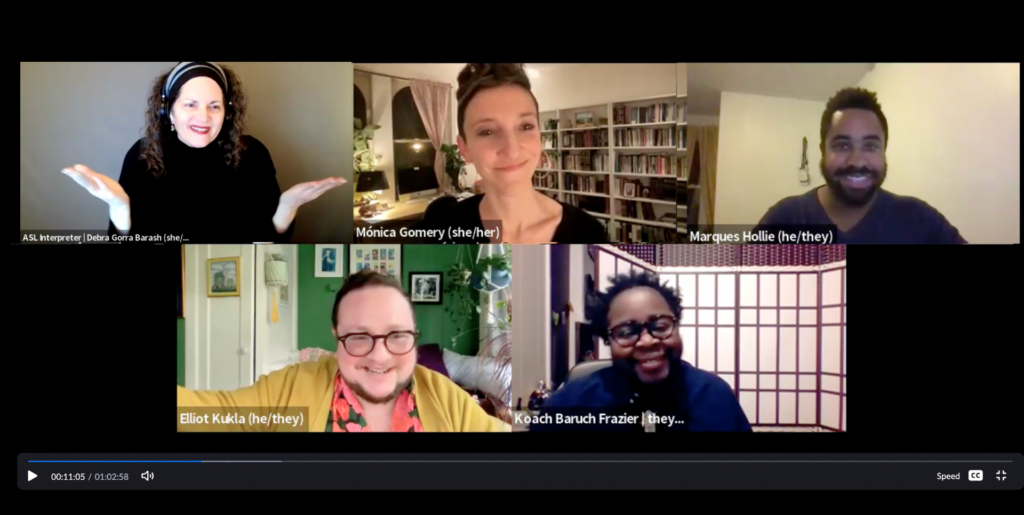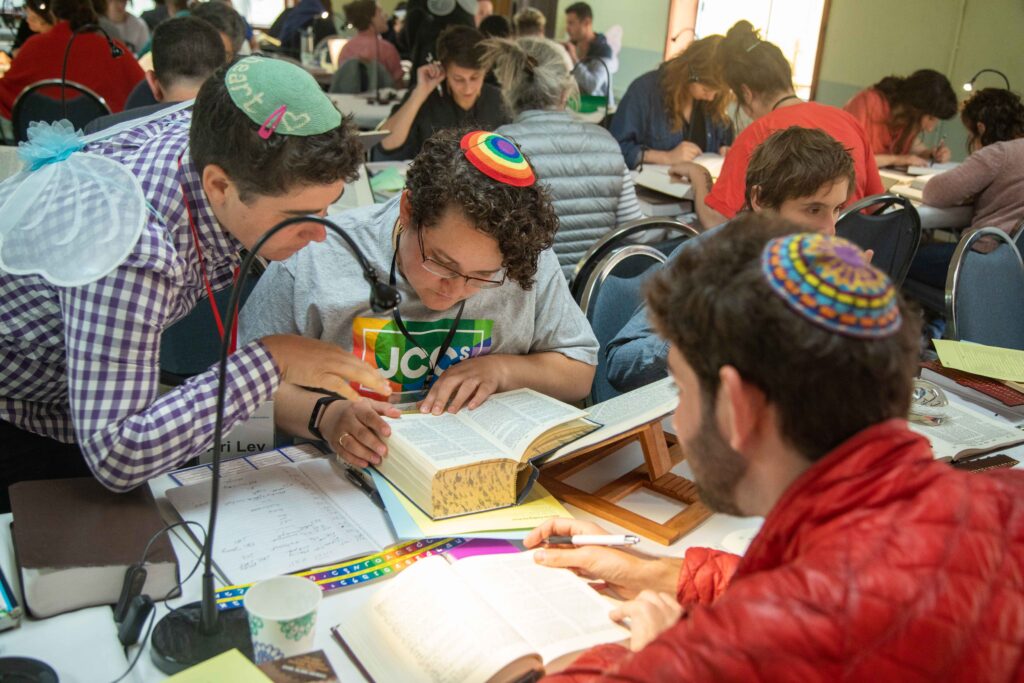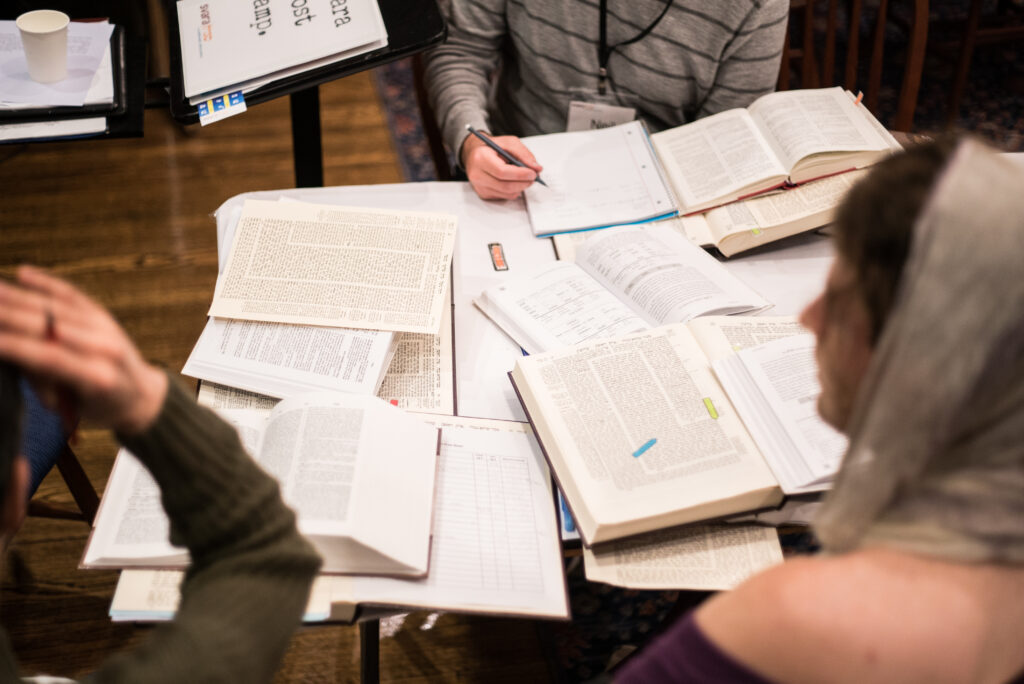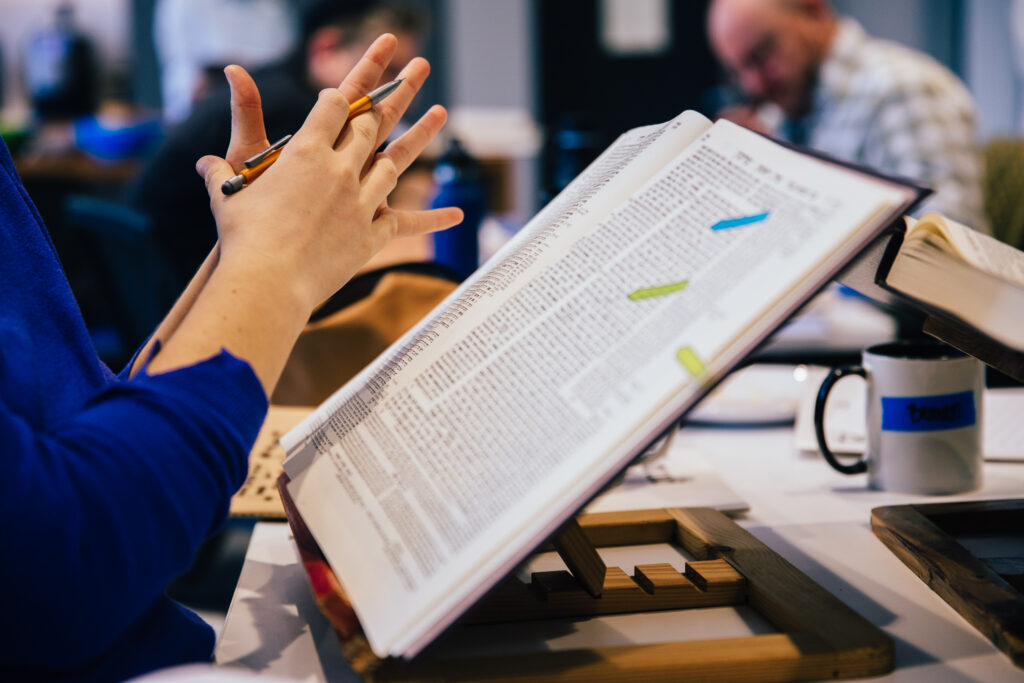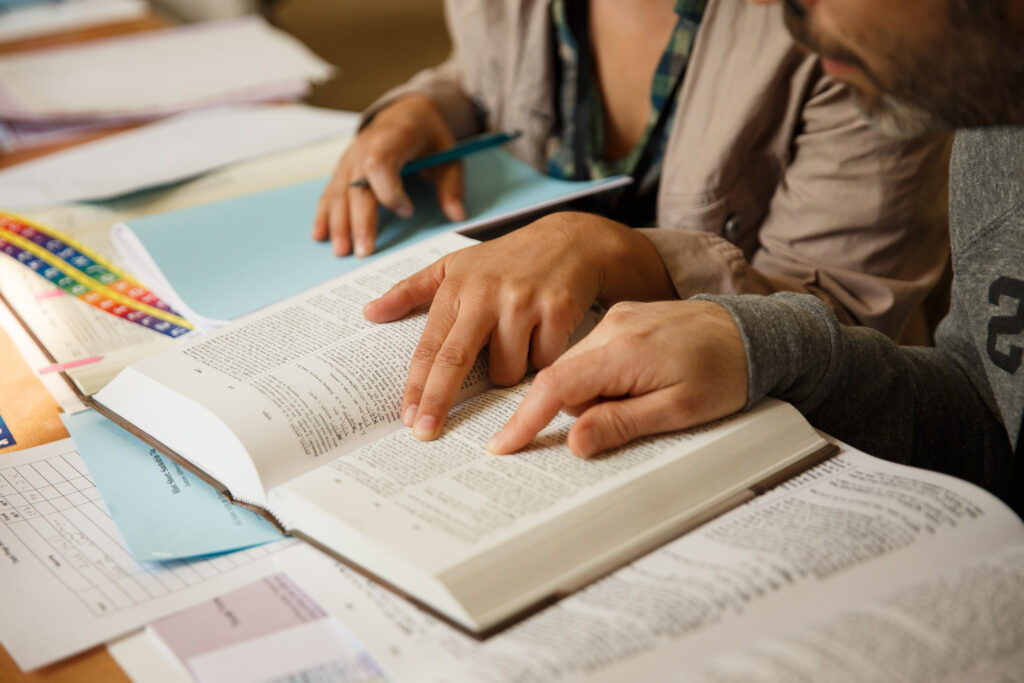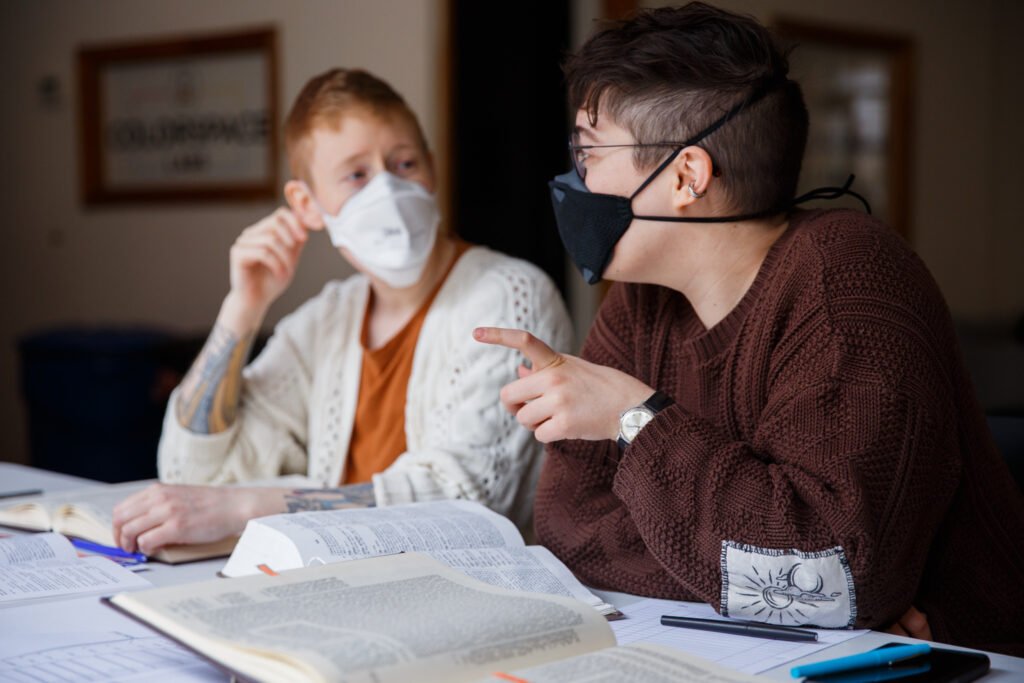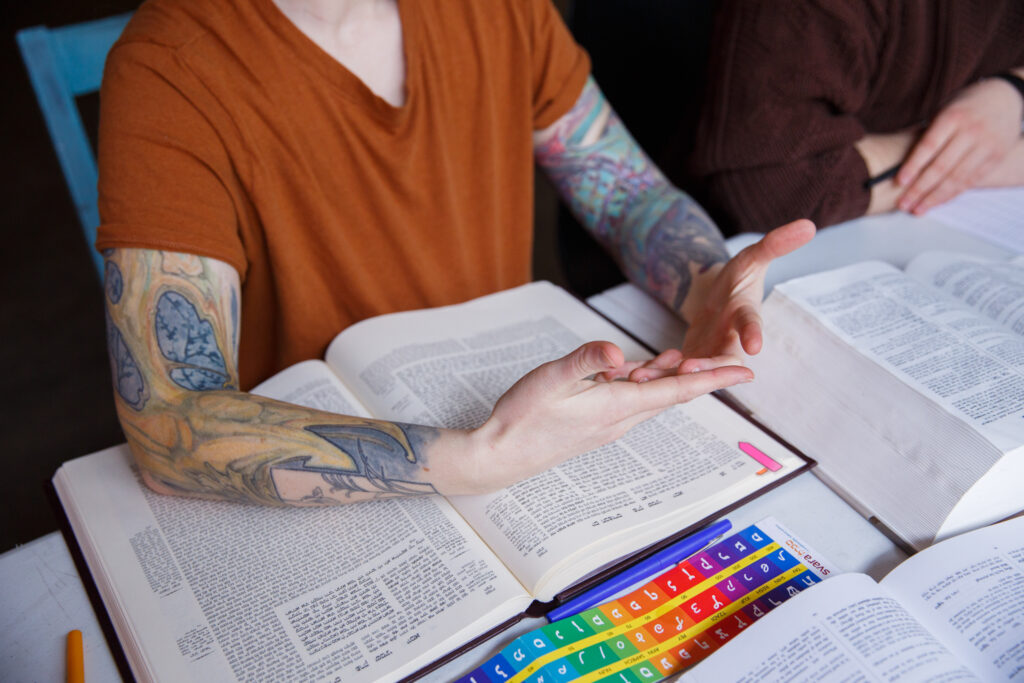This week brought another unforgettable installment of The Unrecognizable Jewish Future, a four-part conversation series designed to explore the evolving role of Judaism in our lives through thought-provoking conversations with leading thinkers, teachers, and learners. The speakers who joined us on Sunday – Dr. Koach Baruch Frazier, Rabbi Mónica Gomery, and Rabbi Elliot Kukla – reflected on the tools and traditions they have inherited as well as those they have shaped themselves. They shared what brings them hope during this time of tremendous loss and offered immense gratitude for the precedents created by our very first panel of speakers, our rabbinic ancestors, and each other.
It is a tremendous blessing to be together with you all in community and in conversation, and we hope you’ll join us for the final event on Sunday, February 11th.
Marques Hollie: What change have you seen in Jewish practice, community, or tradition over the past 30 years that has brought you the most hope?
Dr. Koach Baruch Frazier: I think one of the changes that brings me hope is that we’ve accepted that Judaism is a civilization, y’all. We have accepted as truth that there is no one way to be Jewish. This is what my teacher Rabbi Kaplan knew from back in the day. We don’t have to pretend that only certain Jews exist, or that there’s only one way to be a Jew. In my exploration of the longstanding and beautiful traditions and history of African Jews across the diaspora, I am learning so much about how Judaism has traveled. About how it has evolved even in Eretz Africa and made its way through the Transatlantic slave trade to Turtle Island. How it has flourished here despite racism inside and outside of the Jewish community. I am just loving the fact that people are able to express who they are, and we know it’s Jewish. I’m so grateful that trans Jews don’t have to hide anymore. We don’t have to separate any parts of ourselves to come into Judaism, particularly because of projects like SVARA which said “even though there are places you have been cut out of, left out of, told to get out of, you are welcome here. And not only you are welcome, but you will see people just like you in leadership here, as well as those who are learning in the tables at the bet midrash.” Dibarti.
Rabbi Mónica Gomery: One thing that gives me hope is just being alive at a time when your heroes can also be your peers and colleagues and mentors. I really feel like I’m a product of the transformative time which precedes me, and I wouldn’t be here without Benay and Shahanna and Joy and Jill. I also feel like I wouldn’t be here without the leadership and community building and work and writing and teaching of both Elliot and Koach. I feel very humbled in this space. I feel like I am not just standing on the shoulders of giants, but that some giants have reached out and held my hand. What I want to add to what Koach said is that I feel grateful to be alive in a time when we’re asking queer folks and trans folks to transform the tradition both by bringing our voices to it but also by revealing what’s already within the tradition. I learned the term “queer hermenuetics” from Dr. Joy Ladin, which is a theory and theology she applies to discover what queer people uniquely expose that’s already present in our tradition. On top of that, it asks how we shape and create new containers, new pathways, new texts, and new traditions as well. I’m grateful to be alive in a time of thriving proliferation.
Rabbi Elliot Kukla: I will echo a lot of what my brilliant colleagues are saying, and add that queer and trans inclusion has given me hope. SVARA has done a lot to help this kind of inclusion in a way that I was truly not able to visualize. For me, being the first trans rabbi felt like a red sea moment. With an army behind me and an ocean in front of me, I was grappling with not being able to imagine going forward. My mentors and teachers and the people most immediately around me pretty much told me that if I came out publicly I would never work as a rabbi. My mentors didn’t have hope for the concept of a trans rabbi in that moment. And now Koach is about to be ordained and there are so many trans rabbis now. It’s an incredible delight. It feels like the horizon has literally expanded in my lifetime in a way that is beyond imagination. And if I am standing at the red sea in my perspective, I wonder who else is facing an ocean that we can’t even necessarily see right now.
Marques Hollie: What are inputs and insights you have drawn upon – from SVARA and beyond – that have helped you shape your Torah?
Dr. Koach Baruch Frazier: One of the things that I’ve taken and run with is the Black Trans Torah Club, which was born out of needing to be with other people who shared as many identities as I did in the very beginning of lockdown. I was like, “I really feel like if I’m connected with other Black trans Jews, I’ll feel like I can make it.” What that led to was a community of people who learned Torah together for the sake of learning Torah together. It was through that coming together that we learned more about each other. We could support each other when people died, when we didn’t have a way to get to the funeral. We could say kaddish together. If someone had a birthday or if somebody’s book came out, we could celebrate together. Here we are, reaching for each other across the country and across the world. It is literally a tool for my people, one I picked up and ran with. I’m so grateful for that tool.
I’m also thinking about a tradition I believe is Sephardic, but I might be wrong. In the pesach Seder, there’s this question that can be asked: “Where did you come from and where are you going?” I’m thinking about that as we talk about Sankofa, as we talk about being at the red sea and trying to figure out what’s going to happen when we cross. I want to return to this question over and over and over again. I want to offer that if you don’t already ask that at your seder table, offer that to people. Ask them where they come from and where they are going.
Rabbi Mónica Gomery: I was so moved by that image of Sankofa that Shahanna shared last week, and it reminded me of a text I learned from another SVARA faculty member, Rabbi Bronwen Mullin. There’s a teaching in Pirkei Avot that tells us which animals to emulate. One of those animals is a gazelle, and we are called to be fast like a gazelle, to be swift like a gazelle. This past year as we were coming around to the high holidays, I was trying to figure out what it meant to do teshuva, to return or come home to oneself when the world is changing so fast and dramatically, and Bronwen pointed me to this reading on that Pirkei Avot text in the Zohar, which riffs on the gazelle. It asks, “why is the gazelle so unique and unlike any other animal?” And the reason given is that when a gazelle runs, says the Zohar, it moves forward but looks backward. And that feels so resonant right now alongside all the other images that have been shared, all of which connect us to this idea of past and future. Liturgically, it makes me think of the words chadesh yameinu kekedem, “renew our days like the days of before.” What an amazing Jewish paradox, that we get to have the past and the future in the same breath.
For me, what’s core within that is the empowerment that SVARA has really shaped in me. I remember the first time Benay put a masechet in my hands and said, “This is yours. The tradition is in your hands.” I feel like the work we do at SVARA is to demystify the process of learning, to take away the shame and hierarchies of knowledge and language that historically define how we transmit our tradition. At SVARA, we celebrate people for not knowing. We celebrate people for being brave enough to try and pick up the masechet, and reach for it. I think that the gazelle, chadesh yameinu kekedeem, the image of Sankofa, all of this is encapsulated in the idea of traditionally radical learning. This kind of learning can lead us to a totally unknown place that can be a real resource to us. It’s a real tool, to be able to hold the future and the past in one breath. I think that’s embedded in your story, Koach. When we’re lost, when we’re free-falling, when we’re living in late stage capitalism and honestly don’t understand how to imagine what’s coming next, what do we do? We learn. In times of uncertainty, let’s get grounded and anchored in what our ancestors did, and then? Dot dot dot. Ellipses. We don’t need to know the end of that sentence. Our learning will guide us if we look forward and reach back at the same time. I’m so grateful for that. It’s part of our deep, buried, and transmittable super powers in Jewish tradition.
Rabbi Elliot Kukla: I am loving this discussion of how to remain connected to each other and the tradition, to the past and the future. I am thinking about disability justice and all of the people that I’ve had the privilege of being with at the end of their life. What I have received from both of those streams is that in times of a lot of loss, sometimes when we crash, we don’t rebuild right away. Sometimes the looking back is not immediately connected to a looking forward. Sometimes that uncertainty stays uncertain. To reference Benay’s wonderful CRASH theory, we don’t always go to an option 2 or 3 immediately. Sometimes you stay in the rubble. There’s something extremely generative about that. That’s something I’ve learned from People of Color-led disability justice movements, and people who are living with multiple marginalization. I’ve learned how generative it can be to stay with the moment of crash. To not try to make sense too soon out of unbelievable amounts of loss.
Recently I’ve been thinking and learning a lot about how all of this makes neurological sense. How after a loss, our brains need time to reset and re-wire. We can’t actually make sense too soon because we’re filled with cortisol and hormones, and our risk of a heart attack has skyrocketed. If we try to make sense too soon, it’s an oversimplified sense. As a Jewish world right now, we’re in a moment of enormous loss and we’re seeing a huge rush to certainties, and I think the Talmud provides us with a model of something else. Right? The Talmud provides us with this model of staying with loss for much longer than is comfortable. The Talmud depicts generations and generations of staying with uncertainty and grappling with the rubble. The Talmud isn’t something you open to get a clear answer of what happens after the temple falls. It’s an incredibly confusing document. And confusion is not what we organically want after a loss. We want an answer. But Judaism goes counter-instinct. It pushes us to stay in that uncomfortable, crumbled place of loss, in the same way disability justice teaches us to do that. To stay with our imperfection, to stay with our wounding, to stay in the loss as opposed to looking for an answer. Because that answer, if it comes right away, is by definition not going to be a nuanced answer. It’s actually probably somewhat dangerous to ourselves or others because it’s coming from that place of urgency and tension, of quickly needing an answer. I’ll stop there for now. Thank you.
Dr. Koach Baruch Frazier: No, keep going! [laughs] Go on and teach us right now! This is reminding me of the nightclub shootings of our trans and nonbinary siblings in Florida, and how it happened in the midst of all the protesting that was going on, especially in Ferguson, where I was. There was a moment in time when I thought to myself, “what do we do when no one stops dying?” How do we take the time to actually honor the loss and be with the grief, like you were talking about, Elliot. How do we find a way to be with what is. And for me, I think we gotta go back to our tradition. Let’s get down as far as we can go, and do whatever it is we can to be in it. To be inside of it. So that one day, possibly, we can move through it. Because our tradition around mourning and grief is not one of expediency. It takes time.
Marques Hollie: Amein, amein.
___
SVARA is committed to providing inclusive, accessible learning and is thrilled to offer The Unrecognizable Jewish Future as a free series for all. The series does however have real costs, such as paying our tech, captioning and ASL interpreter team. If you feel moved to help support this important work, you can make a tax-free donation today at svara.org/donate. And if your organization is interested in being a sponsor of this series, there is still time! Email Elli Krandel to learn more.

